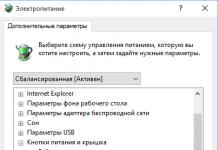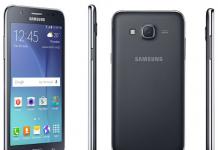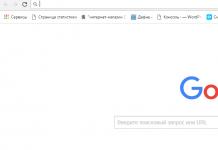When one day after clicking on the die
A black screen appeared on the updated Google AdWords, many marketers choked on their morning coffee. It’s not easy to change habits, the old interface was not the most convenient and at times was damn annoying, but... it was familiar and familiar, like your favorite cup of coffee.
However, time has passed, Google has introduced a number of innovations, and now we have easily found 7 reasons to switch to the new interface right now!
1. New layout of analytics
Analytics in the new AdWords is designed “for people”; it is really convenient to use.
Unlike the previous version, the system offers many “smart little things”: you can change the column width, like in Excel, select a date range with one click, if necessary, remove graphics under the category, a description of the function appears when you hover the cursor, new campaigns and ad groups are created in one movement.

A marketer can create convenient, intuitive and easily modified infographics for any indicator.


A number of new options have appeared, successfully visualized on the so-called overview page. New words in queries, formatted as a tag cloud, which can be immediately added to keywords or negative keywords without tedious transition to other menus.

2. Audience manager
The page displays all statistics in a convenient format; new audiences can be created with one click. In this service, AdWords combined targeting settings for Display Network and remarketing lists for search ads.


3. Promotions
Promotions is a new extension for search advertising and a gift for the marketer. Adds a line highlighted in a separate frame, increases the size of the ad, allows you to select a number of options - set both a discount in monetary terms and a percentage of the price, discounts on certain models, “discounts up to XXX amount” and “discounts from XXX amount”, the name of the holiday on Ukrainian and Russian languages and the duration of the promotion.

4. Search function for additional keywords
When you create a new ad group, AdWords immediately suggests searching for additional keywords. Previously, to find them you had to go to “Tools - Keyword Planner”, now the service is conveniently integrated.

5. Quickly create and edit extensions
When editing ads, you can immediately create and edit extensions. They are not located on separate pages, but on the next tab along with the full statistics table.

6. History of changes in the form of a graph
The history of changes in your account is clearly and conveniently presented in the form of a graph.

7. Convenient testing of the performance of landing pages
Want to evaluate how well your login pages are performing? Easily!

In addition, the new interface works faster and loads easier - it is obvious that Google is primarily concerned with the efficiency and ergonomics of the updated platform.
At first, a lot seems unnecessary, however, after working for a while and getting used to it, you realize that those same “smart little things” teach you good things, and the old interface begins to sorely lack them.
Yes, there is some impression that the update was launched primarily for business owners who would like to try running advertising campaigns on their own, and for those new to AdWords who are not accustomed to working in the Editor and have not yet seen the time when to combine all the data and adequately evaluate the advertising campaign. the campaign was only possible with the help of miles-long Excel spreadsheets.
But... time goes by, services are becoming more and more friendly, considering it important to save the user’s time and effort - and Google cannot help but support the trend. Beautiful dashboards, easy navigation, hotkeys, maximum visualization, audience manager and promotions - the new interface is worth trying, if only to understand what you are giving up.
On August 31, a webinar was held on the updated Google AdWords interface. Senior Product and Solutions Specialist at Google Ilya Sidorov analyzed the main innovations and changes that affected the contextual advertising service. You can watch the webinar recording link, and in this article get acquainted with the main extracts from it.
Google does not stand still and develops along with the rest of the technological world. Over the past two years, developers have been testing updated designs with users in many of their products - Tag Manager, Google Analytics, Firebase Analytics, Google AdWords and others.


A navigation menu (functions that were previously in a horizontal menu are now in a vertical one), customizable dashboards, loading sections, a softer and more pleasant color palette - all this, according to Google, makes working with their services faster and easier.
Another reason why all these changes took place in Google AdWords is the functional limitations imposed on the old familiar design. Given the large number of new settings and additions, it has become more and more difficult for developers "insert" them to the current interface. It became cramped.
As a result of a global update (the last one in AdWords was 8 years ago), we now have a modern, fast and intuitive interface. And since the beginning of 2017, it has become available to many advertisers in a beta version. You will be able to switch between the old and new AdWords designs until the end of this year:
- from old to new or through "gear":

Switching from the old to the new Google AdWords interface
- from new to old:

Switching from the new to the old Google AdWords interface
The changes affected only the external interface; the presentation of material in the Editor or API remained the same.
The entire menu has been moved from the top to the left. The first window that opens after loading adwords.google.com is "Review". It presents key information on selected campaigns in the form of graphs, tables and charts for a certain period of time. Thanks to this display of metrics, marketers can quickly respond to major changes in advertising.

New Google AdWords Interface - Overview
Enabled/paused/deleted campaigns are available in the far left menu. You can choose by type – search network campaigns, display campaigns, shopping campaigns, etc. If necessary, they can be hidden.

Paused and deleted campaigns
Same as in the current interface on the tab "Optimization" AdWords offers advertisers various steps to improve their advertising campaigns. For example, add new keywords, ad extensions, or change your bidding strategy.

New Google AdWords Interface - Optimization
Many users complained that the columns of indicators on different screen diagonals of laptops, mobile devices, personal computers or tablets did not fit into the full screen. And I had to either zoom out or constantly scroll to the side. In the new interface, this problem is solved - now we can manually change the width of each column, easily adjusting it to the desired size.

Changing Column Widths
Since the new interface is still in beta, not all functions are available and work correctly in it. In frequency, search string. Although it has been added to AdWords, at the time of writing this article it is not working properly.

As of 09/14/17, search in the new interface does not work
By settings:
- tab "Additionally" contains a report "Auction statistics"
- Next to the search are displayed: filters, segment, change columns, a menu with campaign statuses and the creation of automated rules
Additional menu for filters, segmentation and changing columns
Similarly in the section "Ad groups".
Tabs have been combined in the new AdWords interface "Ads and Extensions". Text, phone number only, and dynamic search ads are available for search campaigns. For display ads - adaptive and display ads.

Ads and Extensions
Google developers decided to pull extensions closer to the main menu, in the field of view of advertisers, since this option is the most popular and important when setting up search campaigns. Ad extensions play a big role in the final ranking and ranking of ads in search results.
An extension has been added to the new interface "Promo action", which will not be available in the old design. Now it is possible to see what this extension will look like, but it is not possible to apply it to an account, campaign or ad group for Russian users.

“Promotion” ad extension
At the end of August, Google launched a new section "Landing Pages". It provides information about the performance of pages (entrance pages) that users are taken to after clicking on advertisements, as well as mobile click rate—the percentage of clicks on the search network that lead smartphone and tablet users to pages optimized for mobile devices.

Landing Pages
On the tab "Keywords" there are few changes. As well as in "Extensions and Announcements" The main settings are shown at the top. This "Negative words", "Search queries"(for search) and "Auction statistics" in Additional.

Keywords
The new interface has simplified the ability to place bets in various ways:
- setting new rates
- % increase in rates
- reduction of rates in % terms
- raising the cost per click to the level of the bid for the first page indicating the maximum bid
- increasing the bid to the CPC level for display at the top of the page indicating the maximum bid

Changing Maximum CPCs
Chapter "Audience" is now a separate tab. Previously, they were in different places and were separated for search campaigns, display network and video campaigns, which made navigation significantly more difficult for users.
Now, when we select a campaign type in the left menu, we can immediately see audiences and exclusions.

Audiences
Similar settings for "Demography". In the new AdWords interface, the option is currently only available for the USA "Family income". New features that have been added but are not yet available for advertising are highlighted in gray translucent color.

Demography
The menu also includes tabs that were previously located in "Contextual Media Network"- This "Themes" And "Placements". And underneath them "Settings", "Locations", “Ad display schedule”, "Devices" And " History of changes".
Another new feature in the updated AdWords interface is adjusting bids for extensions "Phone numbers". It is located in the tab "Additional rate adjustments" and will be useful for advertisers who focus on calls. In % terms, you can either increase or decrease the rate.

Additional bid adjustments for “Phone Numbers” ad extensions
- search network
- display network
- shopping campaign
- video
- universal campaign for applications (starting October 16, Google will translate all new campaigns like "Mobile application settings" for Universal App Campaigns (UAC), and existing campaigns for search and display advertising, promotion of applications on YouTube, will be stopped on November 15)

The principle of creating advertising campaigns has not changed much. The advertiser is offered to set up advertising campaigns based on marketing goals. It could be like "Visiting the Website"(increased interest), “Showing interest on the site”, "Shopping on the site" And "Call your office"(stimulating actions) to search and "Audience Reach"(increasing brand awareness) and "Content Interactions"(increasing interest) for CCM. When you select a specific goal, recommendations for features and settings that match the selected goals will be available. On the Display Network, when you select a target, certain types of targeting will be available. But if for some reason you choose the wrong goal, you can always change the settings to the desired ones. Or don't use the target at all.
Previously, there was another type of campaign: "Search Network and Optimized Display Network". If this type of advertising campaign is needed, then in the search campaign settings you should set "Yes" in option "Add Display Network".

Search Network and Optimized Display Network - Yes
Targeting settings, language, daily budget, ad extensions - all this remains unchanged. At the end of August, another news came out from Google, in which they announced that from the end of September in AdWords, ad rotation will include only two settings: "Optimize" And "Do not optimize".
If you select the first option, Google will prioritize ads that the system predicts will receive more clicks than other ads in the group. If the advertiser wants ads to be shown evenly, then he can select the option "Do not optimize". To give advertisers even more control, rotation settings will be available at the ad group level. This means that you can choose different rotation options in one campaign.
In the Display Network you can now select a campaign subtype:
- standard media campaign
- smart campaign on the Display Network (in the current interface, available as a marketing goal from the “Call to Action – Attract Customers” category)
- Gmail campaign.

Display campaign subtype
Settings, types of targeting and ad types remained unchanged. The main Google AdWords menu in the new interface has been moved to the top of the page.

Main menu in the new AdWords interface
The complete list of tools is as follows:
- Keyword Planner
- Ad preview and diagnostics
- Audience Manager
- Batch Bidding Strategies
- Negative keyword lists
- General budgets
- Lists of excluded placements
- Excluded placements at the account level
- All mass actions
- Rules
- Scripts
- Added videos
- Conversions
- Google Analytics
- Search attribution
- Bills and payments
- Commercial data
- Account access
- Linked accounts
- Settings
The new way to work with remarketing lists in AdWords is "Audience Manager". When you go to this section, all audiences for this account will become available to us.
On the menu "Audience Sources" You can see the lists used: AdWords tag, Google Analytics, Application Analytics Service, Play, YouTube and customer data (email addresses).

Audience Sources
Statistics on demographics and devices are available in the audience itself:

Statistics by demographics, devices
and user interests:

Statistics on user interests
The arrow next to the menu means going to a third-party resource.

Switching to a third-party resource
In Google AdWords, reports have also been updated, which are placed in a separate block with an icon. The developers combined reports from the header of the old interface and tabs "Quick Statistics".

Reporting in the new Google AdWords interface
And just today, September 14, 2017, Google AdWords announced the launch "Summary"– a new tool, which is a set of cards that display selected indicators and with which you can conveniently view reporting for your entire account.

New - Dashboards in Google AdWords
The new AdWords interface has one more feature - hot keys. Once you are in your account, try pressing the keyboard shortcut:
- GO - go to review
- GC - go to campaigns
- GA - go to advertisements
- GT - search by section
There is also a blog on the ConvertMonster blog, in which I analyzed the Google AdWords interface and shared my own opinion with subscribers regarding the transition to the new interface in the context WAS / HAS BEEN. The Google team has worked hard in recent months: they listened to advertiser feedback, gave people the opportunity to choose and try new products, and fixed many bugs. Some truths remain... But despite this, a global transition to a new design of the contextual advertising service is inevitable and it is better to start getting used to it now in order to be fully equipped at the end of the year!
- Vk.com -
Hello, dear readers of the blog site. In the first article in this series, we looked at general issues, nuances and differences, and also began to create the first advertising campaign, setting basic settings for it. I advise you to at least briefly familiarize yourself with its contents to make it easier to perceive the materials in this publication.
Today we will finish creating an advertising campaign, consider adding new groups for ads and a list of keywords for them (in AdWords, keys are assigned directly to a pool of ads, so that ineffective ones are then automatically eliminated and only those that work well remain). We’ll also look at the basics of creating effective ads and understand the tool’s capabilities for automatically selecting keywords.
Creating groups and individual ads in Google AdWords
The previous article has been completed. The next step is to create ad groups, which we will now do. It is better to create separate ad groups for different categories of goods and services.
If you remember, in the first part I mentioned that in AdWords keywords are set for groups, not for individual ads. This ensures that when searching for a specific word or phrase, the user sees the most relevant ad. As I mentioned, it's a good idea to create separate ad groups for the different products and services you offer.
Create an ad group in Google AdWords
So, after setting the basic campaign settings, we will automatically move to the second step (second tab) of the wizard, which is called "Creating ad groups". Here you will be prompted to immediately enter the address of the page where you will attract users. This is necessary so that the system tries, based on an analysis of the content of this page, to select the most suitable keywords for which ads from this group will be displayed.

First, let's create one group, giving it a name and adding keywords for which you expect ads from this group to be displayed. The keywords issue isn't easy (and we'll get to it later), but hopefully you've already thought of everything, or at least used something from the set of keywords suggested by the Google AdWords wizard.
Actually, the tooltip gives very good advice:

We talked about different types of compliance in some detail in the first article.

You can watch the video for clarity:
Well, or finally, use Google’s own help for selecting good keywords. In general, first of all you need a head, and then experience will come. When you are finished working with groups, click on the “Go to announcements” button located below.
Creating an ad
As a result, you will be taken to the third step of the wizard, where you will be asked to create your first ad. This is a responsible matter and there are no trifles here. If it turns out not to be attractive to the users to whom it will be shown (if they entered the keywords you specified above into Google), then the CTR of the ad will be low and you will be forced to pay for clicks without discounts.
To start create the first ad within the first group. Let's assume that after carefully studying the previous article, you have collected a semantic core and planned your ads. The target URL (landing page that will open after clicking on the ad) will be copied from the previous step of the wizard, if you specified it there for automatic selection of keys. If you haven't indicated it, please indicate it now.

Next, you are asked to fill out fields with the title, description and displayed URL of your site. Google has a Help page dedicated to creating effective ads and an explanatory video on the topic:
In the first article about Google Adwords, I discussed in detail, what is an ad in Google AdWords and what parts does it consist of:
- The title is the most important part, which must correspond to the query entered by the user of the Google search engine and preferably contain the keywords (in any word form) that the user used in his query. There is a length limit of 25 characters.
- The first line of description (in Adwords there are two lines of description) - here you indicate the most important points of your commercial offer, possibly using the query words for which this ad will be displayed. Limited to 35 characters.
- The second line of the description is a call to action (get a discount, call only now, or as in our example - “+100% to your account with every top-up!”). No more than 35 characters.
- Display URL - the URL that will appear in the contextual ad. Usually they just use the address of the main page (the main host, more strictly speaking). Again, no more than 35 characters can be its length.
- Target URL - here you will need to specify the address of your landing page, where, in fact, the user will go when they click on a Google AdWords ad. Here the limitation is less serious - as many as 1024 characters are allowed.
- In the second line (sometimes in the first too) it is advisable to use text that would stimulate clicks on the ad. Usually this is an offer of all sorts of freebies (free shipping, etc.), discounts (today only) and other things that make the user “flow”. Look at the results of your competitors' work for the necessary queries (in Google results), add creativity and...
- One advertisement should not contain requests of different types. Your ad must be a response to this specific user request. For general queries, this condition is very difficult to meet, so it is better to choose keywords such that it is clearly clear what the search engine user wanted to see in response when entering these words.
- If you have a unique selling proposition that your competitors don’t have, then be sure to try to play on this in order to stand out from your neighbors in the search results.
- If the ad is of a “parochial” nature, then this should also be played up so that the user does not have any doubts or hesitations that this is exactly what is intended for him.
- In order for your ad to successfully pass moderation (this is a check for compliance with Google Adwords rules - we’ll talk about it a little later), you need to study at least in general terms the law on advertising in order to know which products can be advertised and which cannot (or with restrictions).
In the right pane of the Google AdWords ad creation window, you can see how it will look when displayed on the side or at the top (or bottom) of the results. If you are satisfied with everything, then click on the “Save” button.
You will be asked to create at least one more ad variant for this group, which can be done using the button shown in the screenshot:

After that you can click on the button "Campaign Check" to get to the fourth step of the setup wizard, where all the settings you have specified will be listed. Although, you could immediately press the button "Save and Finish", if you are confident in advance of your infallibility.


I think that it would be unnecessary to describe filling out various forms of payment information, since this is a purely bureaucratic aspect.
Google Adwords interface features
You can see the newly created campaign by selecting the same item from the top menu of your Google AdWords account. On the page that opens you will see a rather “horrifying” picture with many tabs, filters and parameters. It will take some time to get used to it and get used to it.

You can enter the settings of an individual campaign by clicking on its name either in the left menu or in the central table. There will already be ad groups related to this campaign, the settings of which can again be accessed by clicking on their names. Well, already there you can work with keywords and advertising texts. Those. A strict hierarchy is observed (in descending order) - campaign, ad group, ads and keywords.
Although, being, for example, in the mode of viewing all online campaigns in Google Adwords (the item of the same name in the left menu), you can navigate through the horizontal menu viewing all groups, advertisements, ad extensions (locations on the map, additional links and telephone numbers) and keywords, relevant to all campaigns. In general, this “tool” is quite functional, but at the same time frightening in its sophistication.
It is noteworthy that when adding another ad group to an existing campaign, you will see a single interface (without wizard steps, as we discussed just above), where you will be asked to give the group a name, create the first ad and select a pool of keywords for this group.

Let's return to the interface of the “Campaigns” window (the corresponding item in the top menu). The “Quick Statistics” tab allows you to see the overall picture of a given advertising campaign in quick mode. Naturally, this information will only be available after your ads start running.
In some cases, for different campaigns (for example, those with different regional targeting or focused on different display areas - search or YAN) there is a need copy ads of the same type, so as not to create them every time again. To do this, go from the top horizontal menu to the “Ads” tab, check the boxes you need and click on the “Change” button and select the “Copy” option:

Then open the desired campaign, check the box next to the desired group where you want to paste the copied ads, and select “Paste” from the “Edit” button menu:

You will be asked to confirm the actions being performed:

After this, the advertisements will be copied to the desired group and you can start editing them, if necessary. Just move the mouse cursor to the desired ad and click on the pencil icon that appears in its upper right corner:

Yes, I also want to say about the differences between AdWords and Direct. Keywords, as you noticed, are set for an entire group of ads. Why are ad groups used?? And in order to start showing ads from the group (for these keywords) in uniform rotation mode (for each request a new ad and so on in a circle).
After a certain number of impressions, the system will compare their effectiveness (primarily taking into account the CTR or, in other words, the click-through rate of the ad). As a result, the rotation will no longer be uniform, but with an emphasis on efficiency. More effective ads will receive more impressions, and in the future, ineffective ads will not be shown at all. It turns out that groups in Google AdWords are automatic ad testing mechanism and weeding out unsuccessful options.
This is especially important at the start of a campaign. Create several ad options, and the system itself will determine which of them will “go into circulation” and which “will end up on the shelf.” The period of such test placements usually lasts a couple of weeks, after which all the wheat will have to be sifted from the chaff.
We mentioned just above that all ads in Google AdWords are pre-screened. Moderation is carried out in a semi-automatic mode (most of the ads are moderated programmatically, and a smaller part - manually). The advertisement can be published only after passing moderation (this may take several hours). The status of your ad can be tracked in the “Status” line on the “Ads” tab.
Tools for selecting keywords in Google AdWords
In the system interface (in its top menu) there is a “Tools” tab. In its drop-down list you can see the “Keyword Planner” item, which will help in selecting keywords for text ads that will be displayed in Google search results. There you can also find "KMS Scheduler", which is a tool for selecting queries in the context-media network (what webmasters call Google Adsense).

Let's start with keyword planner. It looks unpretentious:

In principle, this is clear even from the names of its four components, which have the following purpose?
- The “Find Keyword and Ad Group Options” module helps you select keywords. To do this, you can either indicate the product or service that you will advertise, or indicate the page of your website where you will attract visitors, or select a product or service from an existing catalog. See details below.
- If you already have a list of words, then in this module you can see their frequency based on statistics collected by Google.
- Find out the approximate traffic based on the words you collected
- You can combine lists, i.e. words from one list will somehow be combined with words from another (for example, a list of nouns with a list of verbs). Quite a specific and not often required function.
Let's look at the first module called “Find Keyword and Ad Group Ideas”. It allows you to select keywords based on the starting phrase (similar to). It will also be possible to indicate the site to which links will lead from the ad in Google Adwords (indicate the URL of the landing page, the content of which will be analyzed, and keys will be selected based on it). Or you can select one of the product categories available in the list.

In the “Targeting” field, select your region. It will also be possible to select the area of data collection and expand it to “Google and search partners”, including in the statistical database all the data collected, which is installed on thousands of resources on the RuNet.
Over time you will accumulate many stop words (minus words), which should not be in the queries for which you want to show your ads. For example, when trying to sell a product or service, it would be unnecessary to show up for queries with the words “free”, “sell”, “download”, etc. And, of course, they should be selected individually. For example, when selling contact lenses, it would be wise to add “camera”, “camera”, etc. to the stop words.
In general, we turn on our brains and try to get exactly into the target audience (which is interesting to you and who is at the same time interested in your website), while remembering that too active and ill-considered use of negative keywords in Google Adwords can seriously “kill” this same audience. Everything is needed in moderation. List negative keywords, separating them with commas. Also, negative keywords can be added not only in this tool, but also in the list of keywords using the link located at the very end of the list.
However, let's return to our Google AdWords keyword tool. In my opinion, it is not necessary to use the filters located in the right area “Search Options”. You can safely click on the “Get options” button.
After a while you will see results of the keyword selection tool, summarized in a fairly functional and visual table:

What’s remarkable is all the selected options. This is the name of the tab that opens by default - “Ad group options”, and next to each phrase in the “Ad groups” column you see the number of keywords included there. In principle, you could immediately add them in this form to your account, but in practice the system does not collect groups very well, so it is better to manually view the keys.
To see detailed information about each selected key, you can either open collected groups by clicking on their names, or select the “Keyword Options” tab from the top menu. Looking at these keywords, you can probably start making a list of negative keywords for the future.

The data in this table can be sorted in descending or ascending order of indicators in certain columns (by clicking on the column header):

If you decide that these selected queries suit you, you can save to your Google AdWords account, using the button of the same name located in the upper right corner. In the window that opens, you will be given two options to choose from: either add the selected keywords to a new campaign (which you are prompted to create right away), or add them to an existing one:

If you want to add selected keywords, you will be offered to either create a new ad group for them, or again use an existing one:

In this way, individual keywords are added, selected by Google Adwords itself. If you were satisfied with the keywords collected in ready-made groups (suggested by default), then you could use them. They are added to the plan in the same way using the arrow buttons in the last column, and then transferred to the account in an existing or newly created ad group.
I think that's enough for today - we'll continue soon. Don't switch.
To be continued >>> (You can subscribe to the newsletter so as not to miss it)
And here is the continuation: (but you still subscribe - there will be a lot more interesting and useful).
Attracting natural, targeted traffic is difficult. And attracting targeted traffic for competitive commercial queries is becoming an overwhelming task for many small and medium-sized businesses. Try to cope with the internet heavyweights who publish comprehensive guides and consumer reviews every day if you have five people in your auto repair shop. And here’s the problem: the employees do an excellent job of repairing steering columns and adjusting the suspension, but they don’t have time to write articles about it.
Performance marketing from TexTerra – business promotion with payment for leads. We guarantee results even in a complex niche.
There are several ways out of this situation. One of them is attracting targeted traffic using contextual advertising. This guide will teach you how to use Google AdWords, the advertising service of the world's largest search engine.
How to create a Google AdWords account and set up your first campaign
You can create several types of ads using the Ads for Gmail format. With their help, you can show ads to users of the Google mail service.
How to create an app advertisement
On the Display Network, apps can be advertised using two ad formats: text and image.
To create a text ad, select the appropriate format. Use the drop-down menu to select an application store (App Store or Google Play). Add the package name. To do this, you need to insert the application id into the search form. It can be found in the program URL on the Google Play website.
Select the desired package from the list offered by the system.
Add a title and description. Add an image if necessary. Select the type of devices whose users should see your ads. Specify a tracking template. Evaluate the ad's appearance and save your changes.
To create an app image ad, select the appropriate format, select the store, and use the program id to find the package name. Add an image or GIF animation in a suitable format. File requirements are available via the link in the ad editor. Add a tracking template, exclude impressions on tablets if necessary.
Using the application id, find and select the desired program.
Add multiple ad options. They should not be related to each other in meaning. These variations may appear simultaneously or separately depending on the ad format.
If you have an app video ad, upload it. Also add custom images if necessary. If you don't add images or videos, the system will automatically generate an ad using the content on the app's Google Play page. Evaluate the appearance of advertising on different networks. Make changes if necessary and continue setting up your campaign.
How to work with video advertising and shopping ads
To work with video advertising, use the “Video” campaign type. It allows you to display promotional videos on YouTube and other resources. Within the “Video” campaign type, the “Shopping” subtype is available. The tool is designed to display products along with videos.
To create a video ad, launch and set up the appropriate campaign type. Upload a video file to the system or search for the desired role on YouTube. Select an ad format.
- Use TrueView In-Stream to show ads at the beginning, middle, or end of your video. You need to pay if the viewer watches the advertisement for more than 30 seconds.
- The Video Discovery format is suitable for attracting the attention of users who are searching for videos on YouTube or browsing the related videos section. The advertiser pays for clicks to the video.
- Use short bumper ads to introduce your product or brand to your audience. You need to pay for 1000 impressions.
Provide a display and destination URL. Upload a custom companion banner if necessary. The ad will be shown to the audience after verification by Google specialists.
The “Shopping” campaign type is designed to advertise products using shopping ads. The tool is suitable for online stores. To create shopping ads, link your AdWords Merchant Center account. After that, launch and set up a shopping campaign.
Do not try at all costs to use all available ad types at once. For beginners, you can solve the main problems of contextual advertising using text and adaptive ads, as well as using universal application advertising. Online retailers should pay attention to product listings. If you have the ability to create high-quality videos, use video advertising.
How to Use Google AdWords Remarketing
With remarketing, you can show ads to users who have already visited your site. The effectiveness of this function can be explained simply: people are more willing to trust sellers they know. In addition, remarketing allows you to show users ads that match their interests.
For example, you can tell potential customers about new smartphones who have visited the “Smartphones” category pages of your online store at least once. And users who read a review of a new tablet model can be shown tablet advertisements.
You can manage remarketing lists in the “Audience Manager – Audience Lists” section. In the “Create a remarketing list” menu, you can select a source and set the conditions for adding users to the list.
Setting up a remarketing list
To set up remarketing, select the Display Network campaign type. For goals, select “Incentivize Actions – Online Purchases.”
In the campaign settings, in the “Users” section, select the “Remarketing” option.
Select your remarketing audience and continue setting up your campaign.
In this regard, Google announced that it has brought the AdWords service into compliance with the requirements of GDRP. Specifically, AdWords will include a tool to serve non-personalized ads to users who have not consented to being served personalized ads. A similar tool already exists in Google AdSense.
In a post about bringing AdWords into compliance with the requirements of the GDPR, Google says that advertisers must independently obtain user consent to collect and use personal information. This is relevant if the advertiser uses advertising personalization tools, for example, remarketing.
Google has not offered AdWords users any tools or mechanisms to obtain consent from advertisers. Therefore, advertisers still have more questions than answers. AdWords user communities have the following recommendations for those who use remarketing and other ad personalization tools:
- Place a link on the site to Google's privacy and information processing policies.
- Warn users about the use of remarketing and obtain consent.
- Upon request, delete personal information.
Google AdWords currently only requires you to provide contact information for those responsible for GDPR compliance in your account. These contacts are used to inform advertisers about the availability of new tools. You can fill in your contact information in the account menu “Tools – Settings – Data Protection Contacts”.

What you need to know about landing pages
Landing pages improve the effectiveness of advertising campaigns because they drive conversions. However, you will not be able to land every user who follows a link in a contextual ad on a landing page specially created for the advertising campaign. This needs to be explained with an example.
What conclusion can be drawn from these examples? You can use landing pages created specifically for a specific campaign. However, you will also have to use regular sections of the site as landing pages. Therefore, pay attention to the usability of the resource as a whole.
.You can use AMP as a landing page in Google AdWords
In the fall of 2017, after beta testing, Google AdWords opened up the opportunity for everyone to use accelerated mobile pages as landing pages. The essence of the innovation: the advertiser can specify a link to AMP as a landing page.
Google caches accelerated pages whenever possible and serves cached versions to visitors. Thanks to this, AMP loads orders of magnitude faster than regular pages. To clearly demonstrate the benefits of accelerated pages, Google published an animation. On the left, AMP is used as a landing page, and on the right, a regular page.
The cost of a click in Yandex Direct has become prohibitively high, and the number of applications has fallen? This is not surprising, today it is not so difficult; setting up Google AdWords advertising looks much more complicated. In view of this, with the right approach, advertising in Google Adwords can give very good results with a very modest budget.
That is why, especially for you, we have prepared step-by-step instructions for setting up Google AdWords advertising, relevant for 2019-2020. After reading it you will learn:
- how to set up a Google account;
- how to run ads in Google AdWords Express;
- how to create and set up an advertising campaign;
- what types of ads are there and which one to choose;
- how to structure a campaign using ad groups;
- how to create high-quality advertisements.
So let's get started.
Benefits of Google AdWords
Let's start by talking about the main advantages.
- Lower cost per click relative to Yandex Direct. As I said at the beginning of the article, high competition and a heated auction make Direct an unaffordable luxury. True, this applies to a greater extent to the most competitive niches, but will soon affect all areas.
- Selecting platforms on which advertisements are displayed.
- Display in the results of Google search partners (mail.ru, begun, etc.).
- Ability to upload parameters of one campaign for new ones (you don’t have to fill out the same fields several times).
- The impact of ad quality on positions and cost per click. Thanks to a more informative and clickable ad, you can show in 1st place and pay less per click than when shown in 3rd place.
- Allocation of budget by time when you can get the most conversions.
- Ability to set up payment for conversions on the site, rather than per click.
Additional settings
Now go below and open additional settings by clicking on it. This is where we will configure ad extensions.
Structured descriptions
In structured snippets, you can add many additional extensions (by title type) to your ads:
- brands;
- neighborhoods;
- courses;
- places;
- models;
- studying programs;
- recommended hotels;
- styles;
- insurance protection;
- types;
- facilities;
- services;
Depending on the advertised business, you can select the necessary items and add a short description or name (no more than 25 characters) for each. First of all, you should pay attention to the types of headings: brands, places, amenities and services.
 Adding structured descriptions
Adding structured descriptions


























